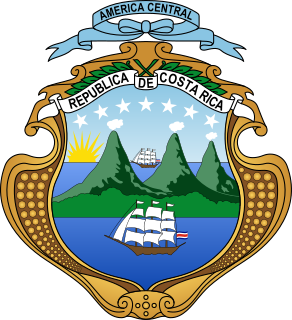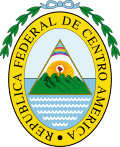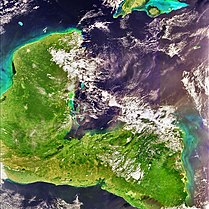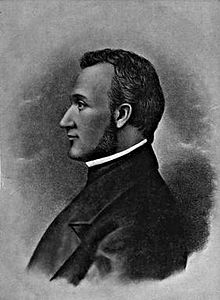
Central America is a region of North America. It is bordered by Mexico to the north, Colombia to the south, the Caribbean Sea to the east, and the Pacific Ocean to the west. Central America consists of seven countries: Belize, Costa Rica, El Salvador, Guatemala, Honduras, Nicaragua, and Panama. Their combined population is estimated at 52.18 million (2022).

Yugoslavia was a country in Southeast Europe and Central Europe for most of the 20th century. It came into existence after World War I in 1918 under the name of the Kingdom of Serbs, Croats and Slovenes by the merger of the provisional State of Slovenes, Croats and Serbs with the Kingdom of Serbia, and constituted the first union of the South Slavic people as a sovereign state, following centuries in which the region had been part of the Ottoman Empire and Austria-Hungary. Peter I of Serbia was its first sovereign. The kingdom gained international recognition on 13 July 1922 at the Conference of Ambassadors in Paris. The official name of the state was changed to Kingdom of Yugoslavia on 3 October 1929.
A federal republic is a federation of states with a republican form of government. At its core, the literal meaning of the word republic when used to reference a form of government means: "a country that is governed by elected representatives and by an elected leader rather than by a king or queen".

The United Mexican States is a federal republic composed of 32 Federal Entities: 31 states and Mexico City, an autonomous entity. According to the Constitution of 1917, the states of the federation are free and sovereign in all matters concerning their internal affairs. Each state has its own congress and constitution.

A federation is a political entity characterized by a union of partially self-governing provinces, states, or other regions under a central federal government (federalism). In a federation, the self-governing status of the component states, as well as the division of power between them and the central government, is typically constitutionally entrenched and may not be altered by a unilateral decision, neither by the component states nor the federal political body. Alternatively, a federation is a form of government in which sovereign power is formally divided between a central authority and a number of constituent regions so that each region retains some degree of control over its internal affairs.

The Federal Republic of Central America, also called the United Provinces of Central America in its first year of creation, was a sovereign state in Central America that consisted of the territories of the former Captaincy General of Guatemala of New Spain. It existed from July 1823 to February 1841 as a democratic republic.

The national flag of Costa Rica is based on a design created in 1848 and consists of two blue stripes, two white stripes, and a central red stripe which is twice as wide as each of the other four. The civil flag omits the coat of arms seen on the state flag, since the state variant is only permitted to be used by the government.

The official coat of arms of the Republic of Costa Rica was designed in 1848, with modifications in 1906, 1964, and 1998. The latest change was the addition of smoke to distinguish the three volcanoes.

The Greater Republic of Central America, later the United States of Central America, originally planned to be known as the Republic of Central America, was a short-lived political union between El Salvador, Honduras, and Nicaragua, lasting from 1896 to 1898. It was an attempt to revive the failed Federal Republic of Central America that existed earlier in the century.
A central government is the government that is a controlling power over a unitary state. Another type of distinct but sovereign political entity is a federal government, which may have distinct powers at various levels of government, authorised or delegated to it by the federation and mutually agreed upon by each of the federated states. Though inappropriate, the adjective "central" is also sometimes used to describe the government of a federation.

The decolonization of the Americas occurred over several centuries as most of the countries in the Americas gained their independence from European rule. The American Revolution was the first in the Americas, and the British defeat in the American Revolutionary War (1775–1783) was a victory against a great power, aided by France and Spain, Britain's enemies. The French Revolution in Europe followed, and collectively these events had profound effects on the British, Spanish, Portuguese, and French colonies in the Americas. A revolutionary wave followed, resulting in the creation of a number of independent countries in Latin America. The Haitian Revolution lasted from 1791 to 1804 and resulted in the independence of the French slave colony. The Peninsular War with France, which resulted from the Napoleonic occupation of Spain, caused Spanish Creoles in Spanish America to question their allegiance to Spain, stoking independence movements that culminated in various Spanish American wars of independence (1808–33), which were primarily fought between opposing groups of colonists and only secondarily against Spanish forces. At the same time, the Portuguese monarchy fled to Brazil during the French invasion of Portugal. After the royal court returned to Lisbon, the prince regent, Pedro, remained in Brazil and in 1822 successfully declared himself emperor of a newly independent Brazilian Empire.

Gran Colombia, or Greater Colombia, officially the Republic of Colombia, was a state that encompassed much of northern South America and part of southern Central America from 1819 to 1831. It included present-day Colombia, mainland Ecuador, Panama, and Venezuela, along with parts of northern Peru and northwestern Brazil. The terms Gran Colombia and Greater Colombia are used historiographically to distinguish it from the current Republic of Colombia, which is also the official name of the former state.
A province is almost always an administrative division within a country or state. The term derives from the ancient Roman provincia, which was the major territorial and administrative unit of the Roman Empire's territorial possessions outside Italy. The term province has since been adopted by many countries. In some countries with no actual provinces, "the provinces" is a metaphorical term meaning "outside the capital city".
A democratic republic is a form of government operating on principles adopted from a republic and a democracy. As a cross between two exceedingly similar systems, democratic republics may function on principles shared by both republics and democracies.
The Central America-4 passport is a common-design passport issued by the Central America-4 Border Control Agreement member states. Although the design had been in use by Nicaragua and El Salvador since the mid-1990s, it became the norm for the CA-4 in January 2006. The main features are the navy blue cover with the words "Centroamérica" and a map of Central America, with the territory of the issuing country highlighted in gold. Costa Rica, not a C-4 Agreement member, also uses a passport with the inscription "América Central", retained from the Federal Republic of Central America and included in its coat of arms.

The Centralist Republic of Mexico, or in the anglophone scholarship, the Central Republic, officially the Mexican Republic, was a unitary political regime established in Mexico on October 23, 1835, under a new constitution known as the Seven Laws after conservatives repealed the federalist Constitution of 1824 and ended the First Mexican Republic. It would ultimately last until 1846 when the Constitution of 1824 was restored at the beginning of the Mexican American War. Two presidents would predominate throughout this era: Santa Anna, and Anastasio Bustamante.
The Government of Somalia (GS) is the internationally recognised government of Somalia, and the first attempt to create a central government in Somalia since the collapse of the Somali Democratic Republic. It replaced the Transitional Federal Government (TFG) of Somalia on 20 August 2012 with the adoption of the Constitution of Somalia.

The Free State of Costa Rica was the name acquired by Costa Rica after its split from the Federal Republic of Central America in 1838 and until the proclamation of the First Costa Rican Republic in 1847.
Relations between the Greater Republic of Central America, also known as the United Provinces of Central America, and the United States were formally established in 1896 following El Salvador, Honduras, and Nicaragua agreeing to form a union similar to the former Federal Republic of Central America. Relations lasted until 1898 when the Great Republic dissolved and relations with the United States continued with the individual states of El Salvador, Honduras, and Nicaragua.



























